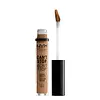NYX Cosmetics Can't Stop Won't Stop Contour Concealer Versus Saie Slip Tint Radiant All-Over Concealer
What's inside
What's inside
 Key Ingredients
Key Ingredients

 Benefits
Benefits

 Concerns
Concerns

 Ingredients Side-by-side
Ingredients Side-by-side

Water
Skin ConditioningCyclopentasiloxane
EmollientMethyl Methacrylate Crosspolymer
Cyclohexasiloxane
EmollientButylene Glycol
HumectantPEG-10 Dimethicone
Skin ConditioningTrimethylsiloxysilicate
EmollientPolyglyceryl-3 Polydimethylsiloxyethyl Dimethicone
Skin ConditioningSilica Dimethyl Silylate
EmollientSodium Chloride
MaskingTriethoxycaprylylsilane
Dimethicone
EmollientDimethicone/Vinyl Dimethicone Crosspolymer
Skin ConditioningAluminum Hydroxide
EmollientDisodium EDTA
Propylene Carbonate
SolventDisteardimonium Hectorite
StabilisingEthylhexylglycerin
Skin ConditioningCetyl PEG/PPG-10/1 Dimethicone
EmulsifyingTocopherol
AntioxidantPentaerythrityl Tetra-Di-T-Butyl Hydroxyhydrocinnamate
AntioxidantPhenoxyethanol
PreservativeIron Oxides
CI 77891
Cosmetic ColorantWater, Cyclopentasiloxane, Methyl Methacrylate Crosspolymer, Cyclohexasiloxane, Butylene Glycol, PEG-10 Dimethicone, Trimethylsiloxysilicate, Polyglyceryl-3 Polydimethylsiloxyethyl Dimethicone, Silica Dimethyl Silylate, Sodium Chloride, Triethoxycaprylylsilane, Dimethicone, Dimethicone/Vinyl Dimethicone Crosspolymer, Aluminum Hydroxide, Disodium EDTA, Propylene Carbonate, Disteardimonium Hectorite, Ethylhexylglycerin, Cetyl PEG/PPG-10/1 Dimethicone, Tocopherol, Pentaerythrityl Tetra-Di-T-Butyl Hydroxyhydrocinnamate, Phenoxyethanol, Iron Oxides, CI 77891
Water
Skin ConditioningCaprylic/Capric Triglyceride
MaskingHelianthus Annuus Seed Oil
EmollientGlycerin
HumectantC13-15 Alkane
SolventDicaprylyl Ether
EmollientPolyglyceryl-3 Polyricinoleate
EmulsifyingLauroyl Lysine
Skin ConditioningMica
Cosmetic ColorantDisteardimonium Hectorite
StabilisingPolyglyceryl-6 Polyhydroxystearate
EmulsifyingPolyglyceryl-6 Polyricinoleate
EmulsifyingSilica
AbrasiveSodium Chloride
MaskingSodium Hyaluronate
HumectantNiacinamide
SmoothingPolyglutamic Acid
Skin ConditioningOryza Sativa Bran Extract
Skin ConditioningEmblica Officinalis Fruit Extract
Skin ConditioningAlthaea Officinalis Root Extract
Skin ConditioningTocopherol
AntioxidantPolyglycerin-6
HumectantGlyceryl Caprylate
EmollientCaprylhydroxamic Acid
Trihydroxystearin
Skin ConditioningTriethoxycaprylylsilane
Ascorbyl Palmitate
AntioxidantTitanium Dioxide
Cosmetic ColorantCI 77891
Cosmetic ColorantIron Oxides
Water, Caprylic/Capric Triglyceride, Helianthus Annuus Seed Oil, Glycerin, C13-15 Alkane, Dicaprylyl Ether, Polyglyceryl-3 Polyricinoleate, Lauroyl Lysine, Mica, Disteardimonium Hectorite, Polyglyceryl-6 Polyhydroxystearate, Polyglyceryl-6 Polyricinoleate, Silica, Sodium Chloride, Sodium Hyaluronate, Niacinamide, Polyglutamic Acid, Oryza Sativa Bran Extract, Emblica Officinalis Fruit Extract, Althaea Officinalis Root Extract, Tocopherol, Polyglycerin-6, Glyceryl Caprylate, Caprylhydroxamic Acid, Trihydroxystearin, Triethoxycaprylylsilane, Ascorbyl Palmitate, Titanium Dioxide, CI 77891, Iron Oxides
 Reviews
Reviews

Ingredients Explained
These ingredients are found in both products.
Ingredients higher up in an ingredient list are typically present in a larger amount.
Ci 77891 is a white pigment from Titanium dioxide. It is naturally found in minerals such as rutile and ilmenite.
It's main function is to add a white color to cosmetics. It can also be mixed with other colors to create different shades.
Ci 77891 is commonly found in sunscreens due to its ability to block UV rays.
Learn more about CI 77891Disteardimonium Hectorite comes from the clay mineral named hectorite. It is used to add thickness to a product.
It can also help stabilize a product by helping to disperse other ingredients.
Hectorite is a rare, white clay mineral.
Learn more about Disteardimonium HectoriteChances are, you eat sodium chloride every day. Sodium Chloride is also known as table salt.
This ingredient has many purposes in skincare: thickener, emulsifier, and exfoliator.
You'll most likely find this ingredient in cleansers where it is used to create a gel-like texture. As an emulsifier, it also prevents ingredients from separating.
There is much debate on whether this ingredient is comedogenic. The short answer - comedogenic ratings don't tell the whole story. Learn more about comegodenic ratings here.
The concensus about this ingredient causing acne seems to be divided. Research is needed to understand if this ingredient does cause acne.
Scrubs may use salt as the primary exfoliating ingredient.
Learn more about Sodium ChlorideTocopherol (also known as Vitamin E) is a common antioxidant used to help protect the skin from free-radicals and strengthen the skin barrier. It's also fat soluble - this means our skin is great at absorbing it.
Vitamin E also helps keep your natural skin lipids healthy. Your lipid skin barrier naturally consists of lipids, ceramides, and fatty acids. Vitamin E offers extra protection for your skin’s lipid barrier, keeping your skin healthy and nourished.
Another benefit is a bit of UV protection. Vitamin E helps reduce the damage caused by UVB rays. (It should not replace your sunscreen). Combining it with Vitamin C can decrease sunburned cells and hyperpigmentation after UV exposure.
You might have noticed Vitamin E + C often paired together. This is because it is great at stabilizing Vitamin C. Using the two together helps increase the effectiveness of both ingredients.
There are often claims that Vitamin E can reduce/prevent scarring, but these claims haven't been confirmed by scientific research.
Learn more about TocopherolTriethoxycaprylylsilane is a silicone used to bind and stabilize ingredients.
As an emulsifier, it helps prevent ingredients from separating. This can help elongate the shelf life of products.
Triethoxycaprylylsilane is often used to coat mineral sunscreens ingredients to help give a better feel. It also helps reduce oxidative stress in sunscreens.
Learn more about TriethoxycaprylylsilaneWater. It's the most common cosmetic ingredient of all. You'll usually see it at the top of ingredient lists, meaning that it makes up the largest part of the product.
So why is it so popular? Water most often acts as a solvent - this means that it helps dissolve other ingredients into the formulation.
You'll also recognize water as that liquid we all need to stay alive. If you see this, drink a glass of water. Stay hydrated!
Learn more about WaterThis ingredient is a combination of red, black, and yellow iron oxide pigments. This combination of colors is usually found in foundation, because it results in a "skin" color.